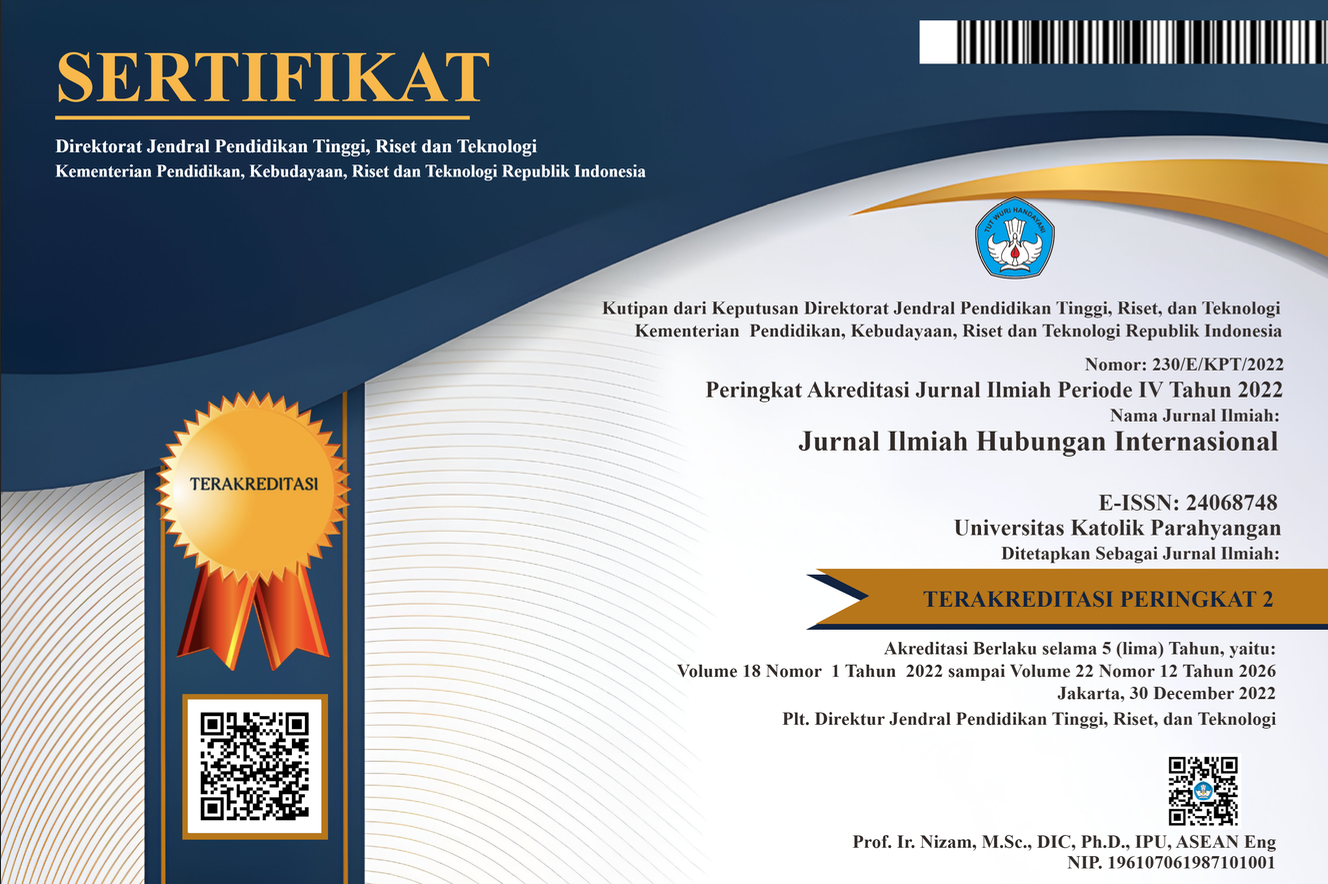Diplomasi Publik Korea Selatan di Indonesia Melalui King Sejong Institute Center Indonesia
DOI:
https://doi.org/10.26593/jihi.v15i2.3415.131-145Keywords:
Diplomasi Publik, Korea Selatan, King Sejong Institute Center IndonesiaAbstract
ABSTRAK
Penelitian ini mengeksplorasi dan mengidentifikasi diplomasi publik Korea Selatan melalui King Sejong Institute Center Indonesia (KSIC). KSIC adalah institusi yang bergerak dibidang pendidikan bahasa dan budaya. Kehadirannya di Indonesia sebagai respon atas minat publik Indonesia yang gemar akan budaya Korea Selatan, khususnya budaya populer (Hallyu) yang mendorong keingintahuan mereka untuk lebih mengenal Korea Selatan. Dengan menggunakan metode penelitian kualitatif dan eksploratif dalam mengidentifikasi data pelaksanaan diplomasi publik di lapangan dengan menggunakan kerangka konseptual dimensi strategis diplomasi publik, untuk mengidentifikasi keberadaan elemen-elemennya, yaitu: listening, advocacy, cultural diplomacy, exchange diplomacy dan international broadcasting. Validasi penelitian ini dengan metoda triangulasi: studi literatur dan wawancara terhadap narasumber signifikan dan khalayak peserta. Hasil penelitian menunjukkan bahwa KSIC Indonesia telah melaksanakan diplomasi publik dan menerapkan beberapa elemen-elemennya dalam kegiatan di setiap dimensi strategis. Walaupun demikian tidak semua elemen dapat dicakup dalam setiap dimensi pelaksanaannya. Melalui diplomasi publik yang dilaksanakan, KSIC Indonesia dalam waktu singkat telah dapat menarik perhatian masyarakat Indonesia terutama masyarakat Jakarta di mana tempat KSIC Indonesia berada. Hasil identifikasi terhadap hierarki penerimaan publik Indonesia yang merupakan hasil dari diplomasi publik KSIC Indonesia menandai bahwa KSIC Indonesia telah melaksanakan tugasnya sebagai perwakilan resmi Negara Korea Selatan.
Kata Kunci: Diplomasi Publik; Korea Selatan; King Sejong Institute Center Indonesia
References
Cho, Y. h. (2011). Desperately Seeking East Asia Amidst The Popularity of South Korean Pop Culture in Asia. Cultural Studies.
Cull, J. N. (2009). Public Diplomacy: Lessons from the past. Los Angeles: Figueroa Press.
Dinnie, K. (2009). Repositioning the Korea Brand to a Global Audience: Challenges, Pitfalls and Current Startegy . Korea Economics Institute Academic Paper Series, 1-5.
Jang, G., & Paik, W. K. (2012). Korean Wave as Tool for Korea's New Cultural Diplomacy. Advance in Apllied Sociology.
Jones, P. (2015). Track Two Diplomacy in Theory and Practice. California: Stanford University Press.
KOCIS. (2019, March 26). Ministry Culture, Sport and Tourism. Diakses dari Korean Cultural Center: http://www.kocis.go.kr/eng/openInformation.do
KSIF. (2018). King Sejong Institute foundation. Diakses dari KSIs Worlwide: https://www.ksif.or.kr/ste/ksf
/hkd/lochkd.do?menuNo=31101100.
Lee, S. J. (2012). South Korea as New Middle Power Seeking Complex Diplomacy. EAI Asia Security Initiative.
Leonard, Mark. (2002). Public Diplomacy. London: The Foreign Policy Centre.
Kim, T., Kwon, H.-J., Lee, J., & Yi, I. (2011). "Mixed Governance" and Welfare in South Korea. Journal of Democracy.
Kwon, S.-H., & Kim, J. (2013). Fron Censorship to Active Support: The Korean State and Korea's Cultural Industries. The Economic and Labour Relations Review.
Ministry of Foreign Affairs Republic of Korea. (2007, January 1). Ministry of Foreign Affairs Republic of Korea. diakses melalui Diplomatic White Paper: mofa.go.kr
Muchtar, J. (2018, May 8). Jakarta Globe. Hallyu: Surfin' the Korean Wave in Indonesia. Diakses melalui https://jakartaglobe.id/culture/riding-the-wave-of-south-korean-pop-culture-in-indonesia
Nye, Joseph. S. (2004). Soft Power: The Means to Success in World Politics. New York: Public Affairs.
Nye, Joseph. S. (2008). Public Diplomacy and Soft Power (Vol. 616). New York: Sage Publications, Inc.
Pinem, W. (2012, 8 9). Seni Berpikir. diakses melalui Korean Wave dan Peningkatan Perekonomian Republik Korea: seniberpikir.com
Tuch, H. N. (1990). Communicating with the world: U.S public diplomacy overseas. New York: St. Martin's Press. Visit Korea. (2011, November 5). Imagine Your Korea. Diakses April 8, 2018, dari website Visit Korea:
english.visitkorea.or.kr
Yang, J. (2012). The Korean Wave (Hallyu) in East Asia: A Comparison of Chinese, Japanese and Taiwanese Audiences Who Watch Korean TV Dramas. Development And Society.
Downloads
Published
How to Cite
Issue
Section
License
This journal uses Creative Commons license (CC BY). We allow readers to read, download, copy, distribute, print, search, or link to the full texts of its articles and allow readers to use them for any other lawful purpose. The author must be aware that the article copyrights will be fully transferred to Jurnal Ilmiah Hubungan Internasional only if the article is accepted to be published in the journal through signing of the Copyrights Transfer Agreement. Authors are allowed to resend their manuscript to another journal or intentionally withdraw the manuscript only if both parties (JIHI and Authors) have agreed on the related issue. Once the manuscript has been published, authors are allowed to use their published article under Jurnal Ilmiah Hubungan Internasional copyrights.








